Lucca is a classic Tuscan city on a human scale, with just enough cultural attractions to beguile but not bewilder. Often bypassed by fans intent on ticking off the Leaning Tower of Pisa, Lucca is Tuscany’s self-deprecating star. It is a mellow city of seductive charms, with ramparts encircling the city, which were transformed into a tree-lined promenade in the 19th century. Lucca has more than its fair share of splendid Pisan-Romanesque churches, with ornate facades of green, grey and white marble. Its perfectly-preserved walled heart, quiet sophistication and peaceful pace of life are all credited with winning over sceptical fans. That’s before talking about its pinky-gold palaces, pedestrian-friendly bastions, crowd-pleasing concerts, enchanting shops and its renowned olive oil and wine estates. In summer, outdoor concerts add to Lucca’s appeal, as do the discreet wine bars and cosy inns. To jaded urbanities, Lucca represents life as it should be led.
Lucca
-
-
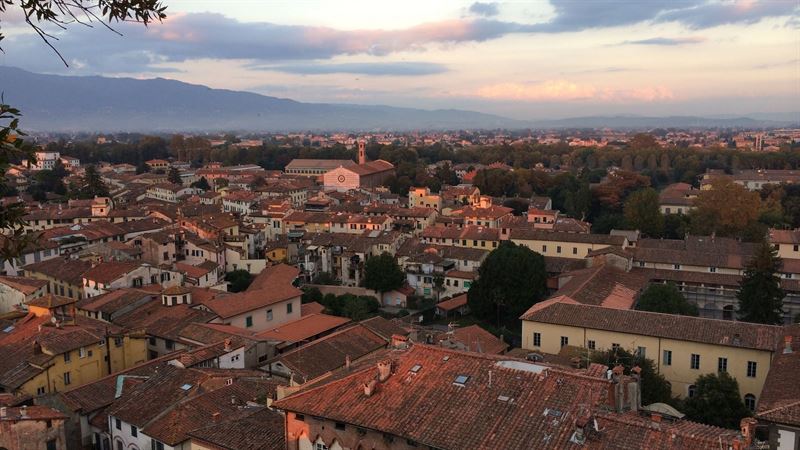
Top Things To Do
Lucca can be as lazy or as active as the mood takes you. Cycle along the city ramparts or climb to the top of the city’s only surviving tower-house. Visit churches, villas, wine estates or grand gardens before hitting the Puccini trail. If feeling lazier, then attend a concert of chamber music in town or browse the speciality shop, often hidden behind elegant, old-world shop fronts.
-
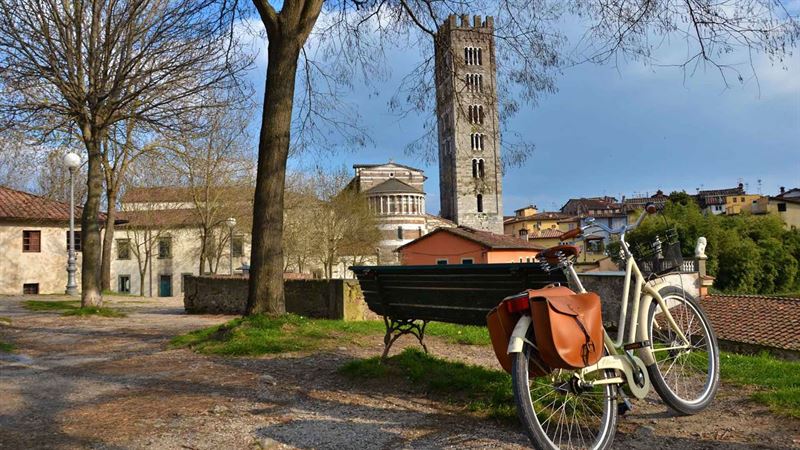
1. Cycling in the city - or strolling along the ramparts
Lucca is full of lanes too narrow for cars, so the locals often get about by bicycle. Ringed by Renaissance walls, the city is made for leisure. The massive ramparts are now the place for jogging, flirting, gossiping and cycling – or several activities at once. It’s hard to believe that Lucca’s 500-year-old walls were built to keep enemies at bay. In 1817, the encircling ramparts were planted with a double row of plane trees, which shade the broad avenue running along the top of the walls. This is now a popular playground, promenade, jogging trail and cycle route. Every now and again, you can take the sloped exit down into town and cycle around the key sites, locking the bike up to a gate when walking around a piazza. This, combined with Lucca’s reputation for culture and intellectual pursuits, has earned the city the nickname of the `Cambridge of Tuscany.’ British fashion designer Paul Smith, a keen cyclist, has a home in the hills and enthuses about cycling in Lucca: “I love cycling around the walls of Lucca; it's so relaxing because there are no cars.” There is something deliciously Continental about cycling around an historic walled city, through its pretty paved streets and piazzas – ideally with a delicious deli lunch tucked away in the basket. You can hire a bike with numerous companies, including Cici Rai close to Porta San Gervasio, the San Gervasio Gate. Cycling is also a healthy alternative to a day on the beach.
Address: New Cicli Rai via San Nicolao 66 - 55100 Lucca
Web: www.ciclirai.it -
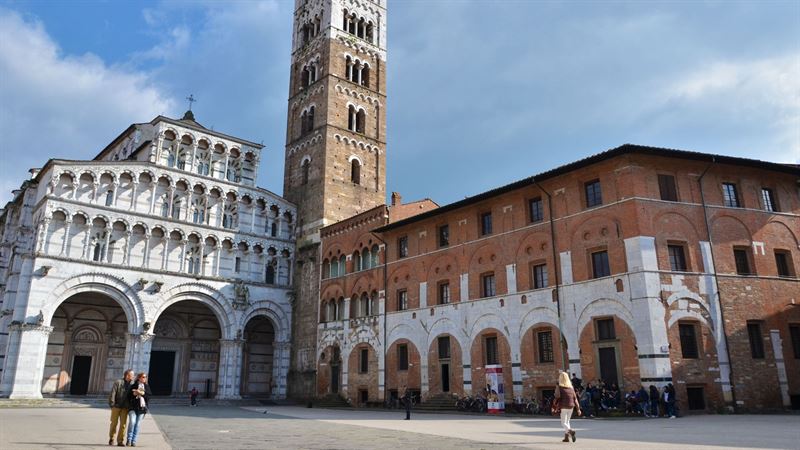
2. Cattedrale di San Martino - see the `true’ portrait of Christ
A path from the city walls leads directly to the predominantly Romanesque Cattedrale di San Martino. Inside is a larger-than-life Crucifixion and supposedly the `true’ portrait of Christ. Even from the outside, the Cathedral is dramatic, with a striking façade decorated with a sculpture of St Martin dividing his cloak (the original sculpture is now just inside the church). The inlaid marble designs are classic Tuscan Romanesque, featuring hunting scenes, with dogs, wild boar, and huntsmen on horseback. Flanking the central portal are scenes of the Labours of the Months and the Miracles of St Martin. Inside is an octagonal tempietto containing the Volto Santo (Holy Countenance), one of the most famous relics of medieval Europe. This touching sculpture was supposedly carved by Nicodemus, who witnessed the Crucifixion – hence believed to be a true portrait of Christ. In fact, the highly stylised figure is probably a 13th-century copy of an 11th-century copy of an 8th-century `original’. Each year, on 13 September, this revered relic is paraded through the candlelit streets in a procession that captivates the whole population. Off the south aisle is the Sacristy and an even greater treasure: Jacopo della Quercia’s tomb of Ilaria del Carretto, who died in 1405. It’s a tender effigy, depicting a faithful dog at her feet, waiting for his mistress to awake. As the wife of Paolo Guinigi, Lord of Lucca, Ilaria died at the age of 24, following the birth of their second child. You can now climb the Campanile, the bell-tower, a mere 217 steps for sweeping views over the city.
Address: Piazza Antelminelli 55100 Lucca
Tel: (+39) 0583.490530
Web: www.museocattedralelucca.it -
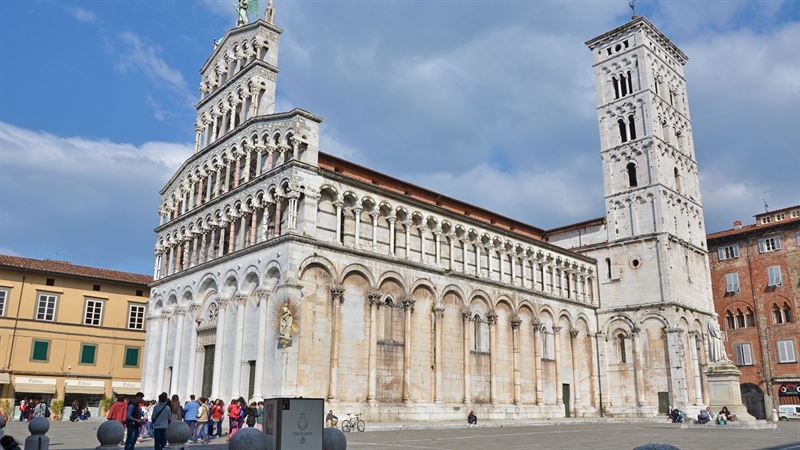
3. San Michele in Foro – for a Romanesque masterpiece
Heading north out of Piazza del Duomo takes you to Piazza San Michele, ringed by Renaissance arcades. At the centre of the square, the church of San Michele in Foro, built on the site of the Roman forum, must be one of the most spectacular Pisan-Romanesque façades in Italy. Pisa was the seminal influence here as its trade links with Spain and North Africa led to its fondness for surface patterning in architecture, copying Moorish tilework and textiles. From Pisa, the oriental influence spread to Lucca. The best Pisan-Romanesque churches come with ornate facades of green, grey and white marble. In this city masterpiece, the chiselled style of the delicate colonnades emphasises the height and exuberance of the façade. Flanked by Lucca’s loveliest bell-tower, the tiered arcades are decorated with delicate motifs and allegories. Carved in green and white marble are hunting scenes featuring exotic beasts, such as bears, dragons and elephants, encountering more domestic animals, such as rabbit, a duck and a crow eating grapes. The church is topped by a huge gilded statue of Archangel Michael slaying a dragon, flanked by two angels.
Address: Chiesa di San Michele in Foro
Piazza San Michele, 55100 Lucca LU, Italy
Web: https://www.visittuscany.com/en/attractions/the-church-of-san-michele-in-foro/ -
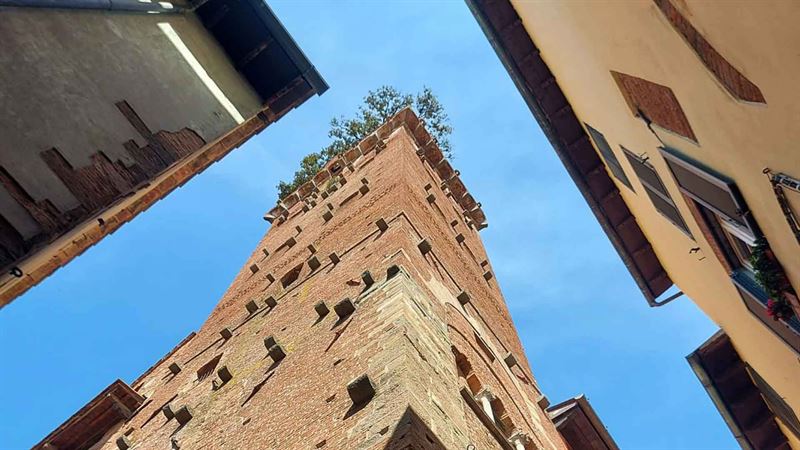
4. Torre Guinigi – for lofty tower-climbing
This is the only surviving tower-house in Lucca, a 14th-century symbol of power and prestige that calls out to be climbed. The wealth of Lucca, like that of Florence, was based on banking and its silk industry. As early as the 12th century, bankers were plying the Mediterranean or travelling north to Bruges, Antwerp and London, buying and selling silk and woollen cloth. Successful bankers, such as the Guinigi family, built ostentatious tower-houses, like this 14th-century affair, now considered a city symbol. As in San Gimignano, such fortified homes were both medieval status symbols and retreats in times of trouble. Climb the 45-metre-high tower (230 steps) to admire rural views, and to make out the outline of Lucca’s Roman amphitheatre (anfiteatro), perfectly framed by medieval townhouses. The style of Torre Guinigi is Romanesque-Gothic, even if Lucca didn’t favour the Gothic style. But here, alongside the Romanesque round arched arcading, are Gothic mullioned windows.
Address: Via Sant'Andrea, 55100 Lucca LU, Italy
Web: https://www.visittuscany.com/en/attractions/the-guinigi-tower/ -
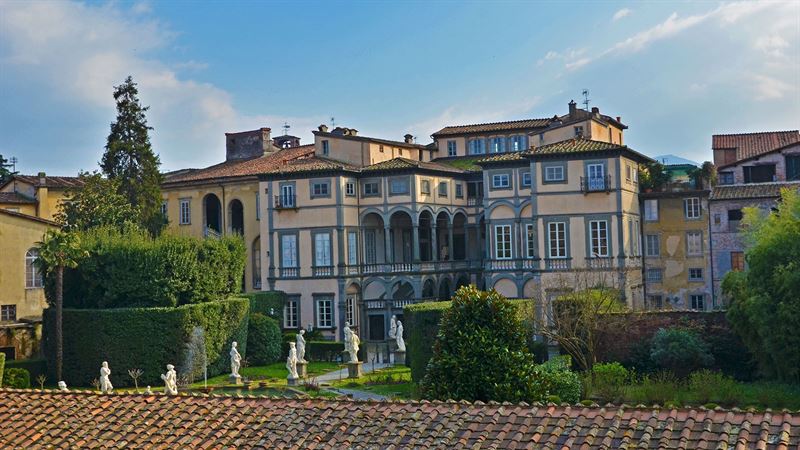
5. Palazzo Pfanner – stroll in baroque gardens
Close to San Frediano church is the Palazzo Pfanner, a delightful 17th-century Lucchese residence, named after a former owner, an Austrian brewer. The sumptuous mansion and Italian-style baroque gardens were designed for a wealthy merchant family. Highlights inside include swathes of 17th-century Lucchese silk in the bedrooms and beer-making equipment in the cellar – the palace was used as a brewery until 1929. The gardens, created around 1700, perhaps by Filippo Juvarra, display such features as a Roman sarcophagus and statues of the Four Seasons. The ornamental pool, lemon house, magnolia and rose gardens form a charming backdrop to the mansion. If pressed for time, you can catch a glimpse of the lovely garden and external staircase by climbing onto the city walls behind San Frediano church and walking left for a short distance. Unsurprisingly, the gardens have appeared in several films, including Portrait of a Lady, based on the Henry James’ novel of the same name. If there in summer, do attend a concert of chamber music in the gardens.
Address: Via degli Asili, 33, 55100 Lucca
Tel: +39 0583 952155
Web: www.palazzopfanner.it -
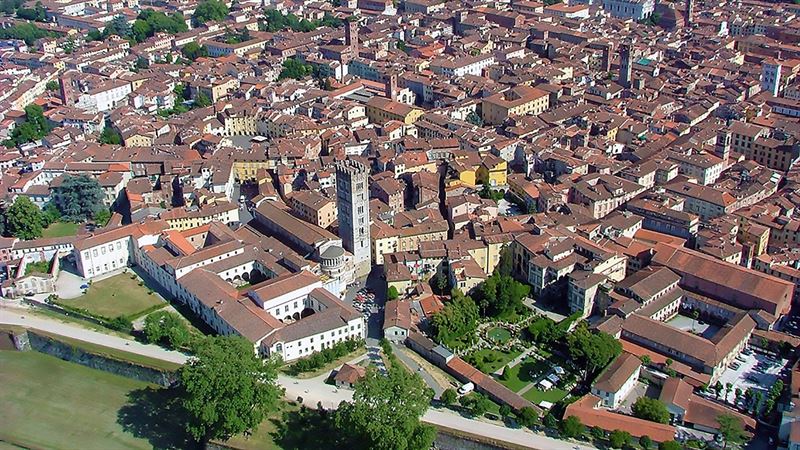
6. Best churches tour – from Roman to Romanesque
If not already sated after seeing the Duomo and San Michele (see entry), visit the best of the rest. The city churches are mostly Romanesque and inspired by Pisa. Yet, given city rivalries, Tuscan Romanesque delights in distinctive regional variations, as in the differentiated stripes and arcading in Lucca. Begin in Piazza del Duomo with the church of Santi Giovanni e Reparata. Originally Lucca’s cathedral, the church has been excavated to reveal its Roman roots. A mosaic floor from a Roman villa was superseded by a 2nd-century Roman bathhouse, which itself gave way to a 5th-century baptistery. A series of churches were added, culminating in the present 12th-century building. Highlights include the Roman font, Romanesque pavements and the coffered ceiling. From here it’s on to San Frediano, with its crenellated bell-tower and its splendid gold-and-blue façade mosaic of Christ in Majesty on the façade. Inside, the dimly-lit interior reveals a massive Romanesque font carved with scenes showing Moses and his entourage of camels, leading his people (dressed in medieval armour) through the divided Red Sea. The church is named after Fridianus, an Irish-born missionary and Bishop of Lucca, who founded the church in the 6th century.
Address: Piazza S. Frediano, 55100 Lucca LU, Italy
Tel: +39 3498440290
Web: www.sanfredianolucca.com -
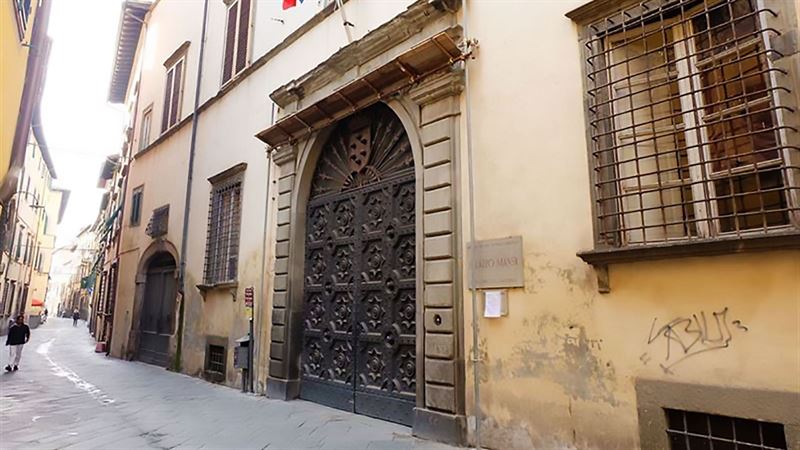
7. Palazzo Mansi -for art in a merchant’s mansion
Lurking at the end of Lucca’s maze of medieval alleys is Palazzo Mansi, a 16th-century merchant’s mansion with a baroque interior. Decorated with much of the original furnishings, it is now home to the Museo e Pinacoteca Nazionale. Deities and allegorical figures romp across the ceilings of the splendidly furnished 17th-century home of Cardinal Spada (1659–1724). Upstairs, at the end of a sequence of rooms decorated around the theme of the Four Elements is a sumptuous bedchamber dedicated to Fire. This fire is not a destructive one, but the flame that burns when Eros strikes with his arrow. The room features a gorgeous double bed, its lovely hangings decorated with birds and flowers. The Pinacoteca (picture gallery) displays works by Tuscan, Venetian and Flemish masters.
Address: Via Galli Tassi 43, 55100 Lucca
Tel: +39 0583-55570
Web: www.luccamuseinazionali.it/en/mansi/museo-nazionale-di-palazzo-mansi -
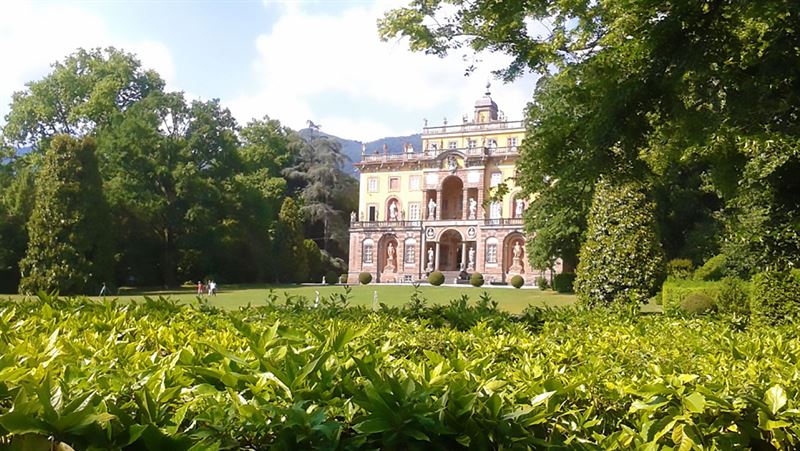
8. Lucchesi villa and gardens tour
Lucca’s villa-studded countryside is a delightful diversion on a hot summer’s afternoon. Most villas are still in appreciative private hands, but often the gardens can be visited even if the house is not open to the public. Wandering through fragrant shrubbery and cool grottoes, past whimsical statuary and fountains, is a reminder of just how wealthy Lucca remains. Two of the grandest are the patrician Villa Torrigiani and the Villa Reale at Marlia both surrounded by beautiful parks. Leave Lucca on the SS12 north, in the direction of the Garfagnana, and after passing through Marlia, turn off at Villa Reale. It was built in the 17th century by the noble Orsetti family but remodelled by Elisa Bacciocchi, Napoleon’s sister. There is a lush park with a lake, which surrounds the formal Italian gardens. Surrounded by clipped yew hedges, its Teatro Verde (outdoor theatre) is the setting for concerts during Lucca’s summer music festival. In Camigliano, near capannori, Villa Torrigiani is a fine example of a late Renaissance villa, owned by the Santini and Torrigiani dynasties since 1636. As Lucca’s ambassador to the French court of Louis XIV, Nicolao Santini remodelled the façade and transformed the gardens. Undertaken in around 1650, the resulting baroque gardens feature grottoes, grotesques, a woodland walk and water gardens.
Address: Via Fraga Alta, 2
55014 Marlia, Capannori (LU)
ITALIA
Tel: +39 0583 30108
Web: www.parcovillareale.it -
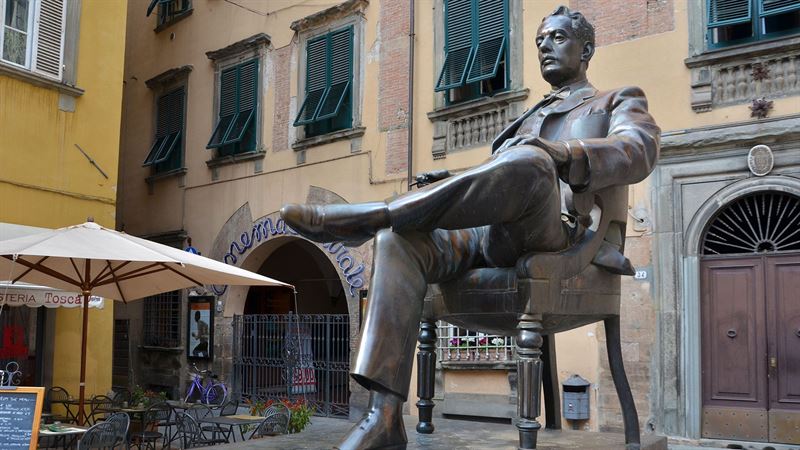
9. The Puccini trail
Opera buffs will be drawn to the birthplace of Lucca’s celebrated composer, Giacomo Puccini (1858-1924). This giant of twentieth-century opera was baptised in the local church, Santi Giovanni e Reparata. The composer is inextricably linked with his Lucca homeland, and even played the organ in Lucca Cathedral. Puccini’s birthplace, the revamped Casa Museo Puccini, is a good starting point for any Puccini tour, and was where he spent a happy childhood and early adulthood. The house stayed within the Puccini family until passing to the Puccini Foundation in 1974. the dining room, complete with arrara marble fireplace, gives a sense of the lives of Lucca’s middle class. The Music Room is the centre of Puccini’s world, with the Steinway piano on which he composed Turandot. For a full Puccini tour, head west to Torre del Lago, on the shores of Lake Massaciuccoli, covered in an itinerary from Viareggio, and in Viareggio itself, as well as in Montecatini Terme, another Puccini haunt.
Address: Museo Puccini, Corte San Lorenzo, 9 - 55100 Lucca
Tel: (+39) 0583 584028
Web: www.puccinimuseum.org -
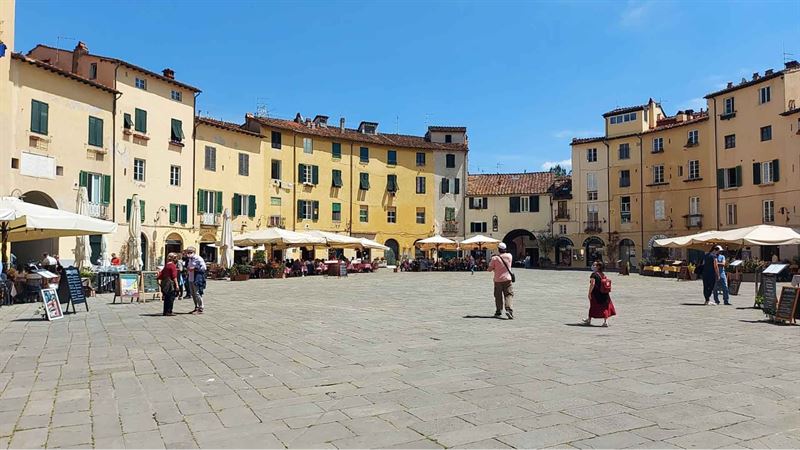
10. Roman designs - on a café-lined square
Roman Lucca survives in the grid-like design of streets, and in the elliptical Piazza dell’Anfi-teatro, still a centre of local life, even if now lined by townhouses. Lucca began as a military colony in 178 BC and, outside the walls, featured a 10,000-seat amphitheatre, founded by Emperor Claudius. In time, it was largely dismantled, and most of the remains lie below street level. During the Middle Ages, however, the surviving amphitheatre walls were recycled in neighbouring townhouses, thus fossilising the city outline and four main entrances. Given that the original Roman street plan is still evident, look out for Roman fragments in surrounding lanes, incorporated in the outer walls of the houses. For a closer look at the resulting egg-shaped piazza, turn into Via delle Chiavi d’Oro and keep going until you reach the curving wall of the amphitheatre. Ringed by pavement cafés, restaurants and souvenir shops, the amphi¬theatre is an atmospheric place to linger over an ice cream or even dinner. Leave through the opposite archway, following the curve of the amphitheatre to Via Fillungo, Lucca’s main shopping street. Then visit the Domus Romana, a Roman home, complete with chance to discover Roman history and even sample Roman food, including focaccia with rosemary. Also call into the church of Santi Giovanni e Reparata for Roman remains.
Address: Via Cesare Battisti, 15
55100, Lucca - Italy
Tel: +39 0583 050060
Web: www.domusromanalucca.it -
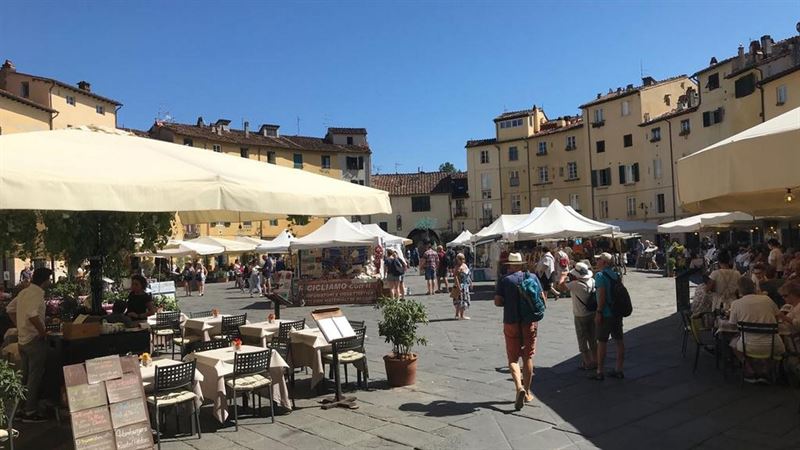
Eating & Drinking
Lucca is a cultural capital in miniature, with discreet bars and cosy inns, perhaps adorned with Art Deco mirrors. Dining out feels effortlessly civilised. All this helps explain why Lucca is the only Tuscan city to see tourism expand exponentially in recent years.
Lucca’s olive trees date back to Roman times, and the region’s ancient vineyards are terraced onto slopes which have been cultivated for wine for centuries. Lucchesi wines range from the rich red Montecarlo di Lucca to the delicate white Colline Lucchesi. Local specialities include an unusual sweet tart of spinach and chard with pine nuts and, inspired by neighbouring Garfagnana, chestnut flour ravioli. The rugged Garfagnana region is just north of Lucca so also expect tasty soups made of spelt (farro), enriched by oil, onions and borlotti beans. And, in season, there are wonderful funghi porcini (ceps) and chestnuts, which find their way into flour and pastries. Those with a sweet tooth will like buccellato, the sweet bread made with raisins and aniseed. This ring-shaped bread, supposedly inspired by a Roman bugle, dates back to Roman rule in Lucca and was the bread of the Roman Legions.
-
Pasticceria Taddeucci
This pastry shop has been in business since 1881 and looks the part with its burnished interior. Come here for the speciality, buccellato, a sweet loaf of bread with raisins and aniseed, either with a coffee or sweet Vin Santo wine. They also do a chocolatey, orange-peel studded version of the bread. The shop’s fans include Pope Jean Paul II and Prince Charles.
Address: Piazza San Michele 34, 5510 Lucca
Tel: 39 0583 494933
Web: www.buccellatotaddeucci.com -
Buca di Sant’Antonio
This formal, renowned restaurant has been in business since 1782 and is a romantic spot for dinner. Drink your complimentary glass of Prosecco while admiring the copper pots strung against the wooden beams. Choose from pricey gourmet versions of Lucchese and Garfagnana classic dishes, such as the ricotta and leek flan, funghi porcini (ceps) risotto, or fettuccine in pigeon sauce, alongside dishes with a more modern slant. Critics think that the cooking isn’t quite on a par with the seductive ambience and superb wine list.
Address: Via della Cervia 3, Lucca
Tel: +39 0583 55881
Web: https://guide.michelin.com/gb/en/toscana/lucca/restaurant/buca-di-sant-antonio -
Cantine Bernardini
This is a delightful inn and wine bar, an osteria-enoteca belonging to the patrician Bernardini family, who also sell wines from their estates. This mid-priced restaurant, wine bar and deli are set in the vaulted cellars of the 16th-century Palazzo Bernardini. Seasonal Tuscan dishes are on the menu, including chestnut-flour ravioli in a wild boar sauce. Also feast on chickpea soup, steak, wild boar terrine, Pecorino cheese, and pasta stuffed with artichokes. The dishes represent the best of Lucca and Garfagnana.
Address: Via del Suffragio, 7, 55100 Lucca LU, Italy
Web: https://www.cantinebernardini.com/ -
Gli Orti di Via Elisa
Set in the heart of town, near Porta Elisa, this established, inexpensive trattoria is a good choice for a light lunch. The zuppa di farro e fagiolo (bean and spelt soup) is a signature dish, as is the vegetable risotto and apple tart. Local produce includes exceptional beans from Lucca, with mushrooms, spelt and Pecorino cheese from neighbouring Garfagnana. This busy trattoria also offers wine-pairing menus.
Address: Gli Orti di Via Elisa, Via Elisa, 17, 55100 Lucca LU
Tel: +39 0583 491241
Web: www.ristorantegliorti.it -
Pizzeria da Felice
Set just behind Piazza San Michele, this bustling, wood-fired pizzeria has been going strong for a century so clearly knows a good pizza. The pizzas can be made with chickpea or chestnut flour, a nod to neighbouring Garfagnana. The mood is rustic and unpretentious, just how the locals like it.
Address: Via Buia 12, Lucca
Tel: 0583 494986
Web: www.pizzeriadafelice.it -
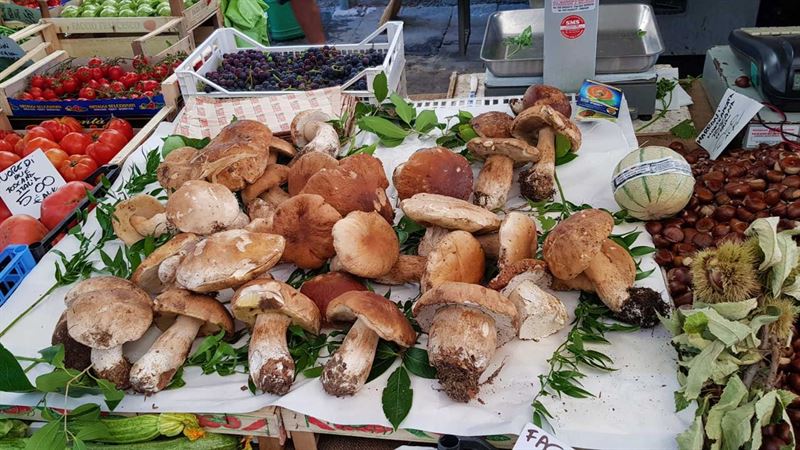
Shopping
Shopping, like dining out, feels effortlessly civilised in Lucca. It’s a delightful mix of ancient and modern, with designer glasses presented in an antique bevelled-glass-and-mahogany display case. The old shop fronts have been wonderfully preserved, complete with swirling gold lettering and mahogany panelling. Revel in window-shopping and admiring the locals, dressed in the softest cashmere and leather. Browse delightfully old-fashioned yet upmarket shops and call into a belle epoque café for an ice cream or traditional pastry. The buccellato bread, made with raisins and aniseed, goes with a coffee or Vin Santo dessert wine.
-
Via Fillungo
There is no escaping Lucca’s main shopping street, an invitingly sinuous street framed by tall houses. Begin in café-lined Piazza Anfiteatro and follow the curve of the amphitheatre to Via Fillungo, a pedestrianised paradise lined by quirky, one-off shops and traditional stores with Art Deco shopfronts. From historic cafes to hip boutiques, Lucca makes shopping a pleasure. After browsing, call into the loungey La Cantina dei Sapori for a drink or wine-tasting over cold cuts and cheese boards, even during a passeggiata (evening stroll).
Address: Via Fillungo, 155, 55100 Lucca LU, Italia
-
L’Erbario Toscano
This temple of Tuscan potions sells natural and organic body, face and beauty products made in the region. The pepe nero (black pepper) products are particularly tempting. In addition, the shop sells Tuscan crafts, from silk scarves to embroidery.
Address: Via Dei Ghivizzani 61,
55041 Capezzano Pianore,
Lucca – Italy
Tel: +39 0584 969660
Web: www.erbariotoscano.it -
Caniparoli Cioccolateria
If you’re looking for sweet souvenirs or just something to munch while walking Lucca’s wall, call into one of the best chocolate shops in town. Try the silky gianduia or the spicy peperoncino versions.
Address: Via San Paolino 44, Lucca
Tel: 0583 53456
Web: www.caniparolicioccolateria.it -
Antica Farmacia Massagli
If you’re brave, try some China, an alcoholic elixir of aromatic herbs and spices the locals swear by for general health: it’s been produced since 1855 as a medicinal pick-me-up.
Address: Piazza San Michele 36, Lucca
Tel: 0583.496067
Web: https://www.anticafarmaciamassagli.it/ -
Parking & Getting Around
Parking in Lucca is slightly easier than in most Tuscan towns. Some parking is available both outside and inside the city walls, with most of it paid parking. However, outside the city walls you might find some free spots, and from there it’s a pleasant 15-minute walk into the city centre. It is simplest to park outside the city walls as, within the walls, most parking is for residents only, indicated by yellow lines. Blue lines indicate where anyone, including tourists, can park.
Outside the city walls, one recommended secure car park is Parcheggio Carducci, just outside Porta Sant'Anna (St Anna Gate), to the south-west of town. Parcheggio Palatucci, situated to the north, is another cheap option, with similar rates, and even a bike rental service on offer. Within the city walls, on the west side, you can find Parcheggio Cittadella. -
Arrival and departure tips
If travelling by car, bear in mind that the A11 runs eastwards to Florence but westwards to Pisa and Viareggio. The rugged Garfagnana area is reached via the SS12 and then on the SS445.
If arriving by train, note that the train station is south of the city walls. You need to follow the path across the moat and walk through the (rather dank) tunnel under Baluardo San Colombano.
If arriving by train and you want to leave luggage or hire a bike, go to Tourist Center Lucca. From the station, turn left to find this handy bike-rental outlet, which has plenty of children’s bikes too.
Address: Tourist Center Lucca - Piazzale Ricasoli 203
Tel: + 39 0583 49440
Web: www.touristcenterlucca.com

























